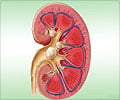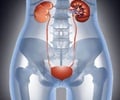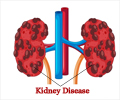A study in JAMA says that adolescents and young adults who had persistent, microscopic blood in their urine (hematuria) were more likely to develop end-stage renal disease

Asaf Vivante, M.D., of the Edmond and Lily Safra Children's Hospital, Tel Hashomer, Israel, and colleagues conducted a nationwide, population-based study in Israel to evaluate the risk of treated end-stage renal disease (ESRD) in adolescents and young adults with persistent asymptomatic isolated microscopic hematuria. The study included medical data from 1,203,626 persons aged 16 through 25 years (60 percent male) who were examined for fitness for military service between 1975 and 1997 and who were linked to the Israeli treated ESRD registry. Incident cases of treated ESRD from January 1980 to May 2010 were included.
Persistent asymptomatic isolated microscopic hematuria was diagnosed in 3,690 of the 1,203,626 eligible individuals (0.3 percent). The condition at enrollment was twice as prevalent among male as female participants (0.4 percent and 0.2 percent). During 21.9 years of follow-up, treated ESRD developed in 26 individuals (0.70 percent) with and 539 (0.045 percent) without persistent asymptomatic isolated microscopic hematuria. A multivariate model adjusted for age, sex, paternal country of origin, year of enrollment, body mass index, and blood pressure at baseline revealed a significantly increased risk of developing ESRD associated with persistent asymptomatic isolated microscopic hematuria. However, the researchers note that the incidence and absolute risk of ESRD were quite low.
"A substantially increased risk for treated ESRD attributed to primary glomerular disease was found for individuals with persistent asymptomatic isolated microscopic hematuria compared with those without the condition. The fraction of treated ESRD attributed to microscopic hematuria was 4.3 percent," the authors write.
"… demonstrating that persistent isolated microscopic hematuria is a risk marker for ESRD highlights the importance of early detection of pre-dialysis chronic kidney disease for the application of current and future strategies to slow the deterioration to ESRD. It also shows the importance of considering complications and comorbid conditions across the range of chronic kidney disease."
"In light of our findings, future studies are warranted to evaluate the utility of population screening in improving clinical outcomes," the researchers conclude.
Advertisement
Editor's Note: Please see the article for additional information, including other authors, author contributions and affiliations, financial disclosures, funding and support, etc.
Advertisement
In an accompanying editorial, Robert S. Brown, M.D., of Beth Israel Deaconess Medical Center, Boston, writes that "in the United States, because the prevalence of chronic kidney disease (CKD) is estimated to be from 70- to 200-fold greater than the prevalence of treated ESRD, perhaps an argument could be made for the inclusion of [urine] dipstick testing for hematuria as part of routine screening of young adults."
"The early identification of persons at risk for CKD also should promote other healthy interventions for smoking, hypercholesterolemia, glycemic control, and reduction of sodium intake. The U.S. Preventive Services Task Force has no current recommendation for CKD screening, but the topic is under consideration."
"… it appears that the time may have arrived for routine urine dipstick screening in adolescents and adults, at least at all initial examinations and perhaps every 5 to 10 years thereafter," Dr. Brown writes.
(JAMA. 2011;306[7]:764-765. Available pre-embargo to the media at www.jamamedia.org)
Editor's Note: Please see the article for additional information, including financial disclosures, funding and support, etc.
Source-Eurekalert















